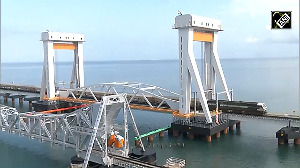After my last article, most people consider me far too cynical and old-fashioned for this raging bull market. Trying to understand my own biases, I felt it would be useful to try and trace the origins of this bull run.
If one goes back to February-March 2003, that would in my mind mark the beginning of the current bull cycle from where the market has already more than doubled over the past 30 months. If one were to accept this as the starting point, how were the conditions then which enabled this bull run?
First of all, the markets in 2003 were very, very cheap, trading at just about 10 times earnings (an all-time low), interest rates had bottomed and there was tremendous surplus capacity available with Indian industry.
Industry had also spent 3-4 years prior to 2003 getting its cost position aligned with global benchmarks, and was thus lean, mean and well-positioned for any uptick in business. Commodity prices were also just beginning to rise.
Basically everything was set for a huge surge in earnings if economic growth were to accelerate (operating leverage), and this is exactly what happened. We had excellent monsoons in 2003-04, and GDP growth accelerated to over 8 per cent, corporate earnings rocketed, rising by over 40 per cent and the return on equity (RoE) and the return on capital employed (RoCE) expanded as corporate India was able to use its idle capacity.
The strong growth in earnings, coupled with rising RoEs and strong free cash flow attracted the attention of investors globally. These trends were only further reinforced in 2004-05 and the current financial year as economic growth remained strong and corporate earnings vibrant. The strong commodity price environment of the past three years further reinforced these trends.
Thus, one aspect of the bull story has been the good news on earnings and RoEs, coupled with very cheap valuations. India had the highest earnings growth and RoEs in the emerging markets universe.
The second aspect of the bull run was the feeling in mid-2003 of the country beginning to move in the right direction in terms of economic policies and reforms. This was the period when the previous NDA government was seen to be at its most effective.
We had hopes of serious progress on the power front, with the passing of the Electricity Act and the privatisation of distribution in Delhi. The template to solving the country's power woes seemed to have been established. On roads and private sector involvement in ports, there was tremendous progress.
Airports were firmly on the privatisation agenda, with the government calling for bids for Mumbai/Delhi airports. The government clearly indicated its desire to move below 51 per cent in PSU banks, and allow entry of foreign banks. The beginnings of some movement on labour law relaxation were also visible.
Divestment was strongly on the agenda, as was the desire to implement mega infrastructure projects like interlinking rivers. Post their expected re-election, investors were expecting the NDA to liberalise FDI in retail, list LIC, hike FDI limits across sectors, and attack many of the other structural issues facing the Indian economy.
All of the above was expected to keep the Indian economy on a decade-long GDP growth trajectory of 7 per cent plus.
The progress and belief in economic reforms accelerating the growth trajectory of the country were the second part of this bull story. That India had begun its journey to fulfil its economic destiny was a common belief.
The third part of this bull cycle is related to trends in global liquidity and the general move of investors towards emerging markets. Strong global liquidity encouraged investors to look for returns wherever they could find them, and India's price momentum was self-reinforcing.
Now if we examine each of these points today, we get a very different picture.
First, on valuations. Trading at 15-16 times earnings, the markets in India are no longer cheap (among the most expensive in the EM universe). Also it is my humble submission that given the slew of capex announcements and fund raisings, RoEs and RoCEs have peaked for corporate India.
Most of the idle capacity available has been used and growth from here needs companies to set up new capacity. Interest rates can only rise and operating leverage diminish.
Thus, even if GDP growth were to remain strong, the pace of corporate earnings will slow and they can no longer grow at 3-4 times nominal GDP.
Free cash flows for corporate India have already turned negative. Slowing earnings, falling RoEs, and declining free cash flow are normally a recipe for P/E contraction, not expansion.
On the reforms front, the less said the better. Not a single item mentioned previously in this article has been implemented or has any chance of being implemented by the UPA alliance. I cannot understand how anyone can genuinely believe that India has entered a new era of 7 per cent plus GDP growth in the absence of progress on power reforms and labour laws, and other structural impediments.
The UPA alliance has even managed to sidetrack the roads programme for the past 12 months. I think investors are deluding themselves if they think economic performance in India has totally delinked from governmental action on reforms/infrastructure and governance in general.
If this government does not get its act together on electricity, roads, railways, airports, etc. these infrastructure constraints are bound to eventually short-circuit growth. Does any investor truly believe this government will be able to attack the structural constraints holding back industry?
On the liquidity front also, the party cannot last for ever. Emerging markets have had five good years in relative terms and could easily reverse. Global interest rates are poised to rise and FII inflows into India are at unsustainable levels.
This bull run began with very cheap markets, strongly accelerating earnings, rising RoEs, and the hope that the country was on the right track in terms of structural reforms. The external liquidity environment was also very supportive for investors to buy into a long-term story like India.
Most of these factors have now reversed. Yet the bulls expect markets to keep rising. A period of consolidation is the best-case outcome to my mind.







 © 2025
© 2025